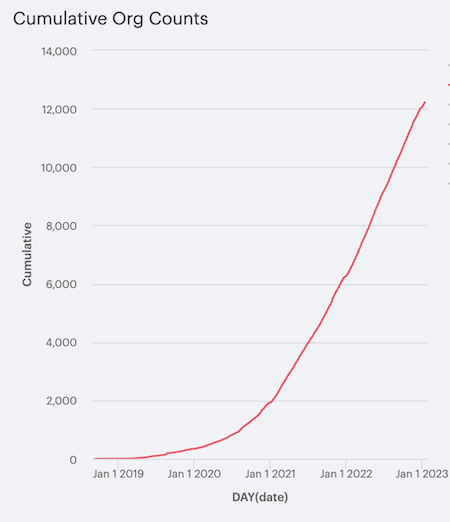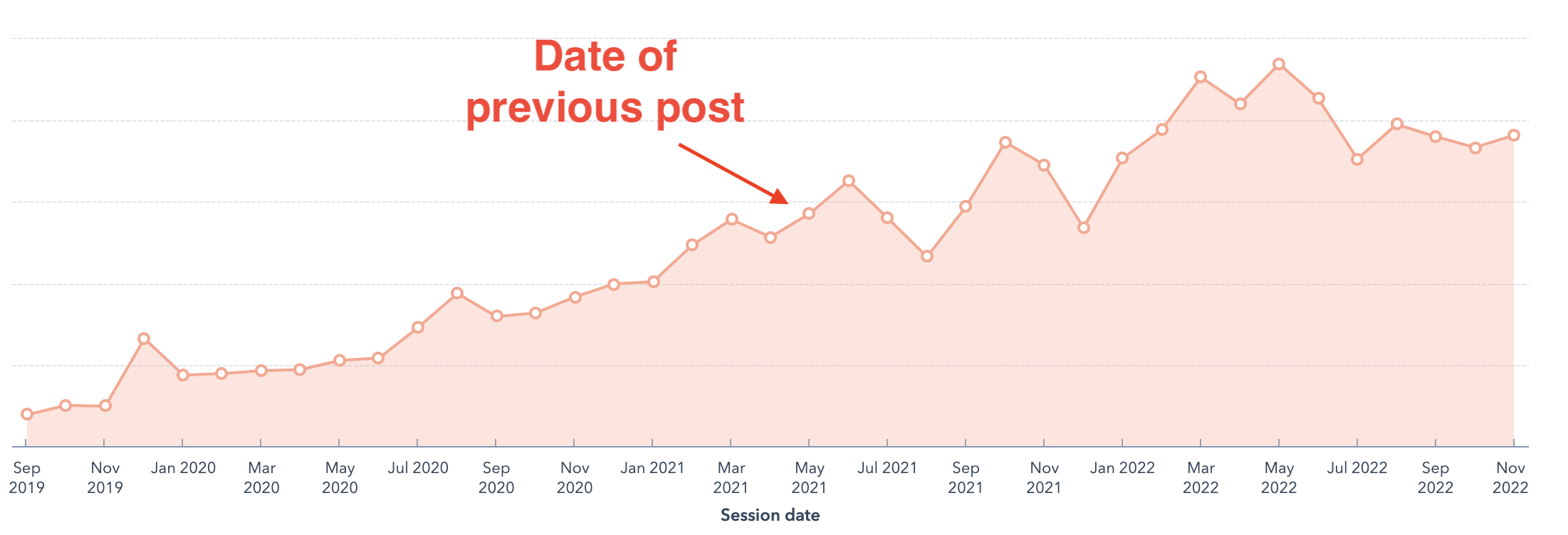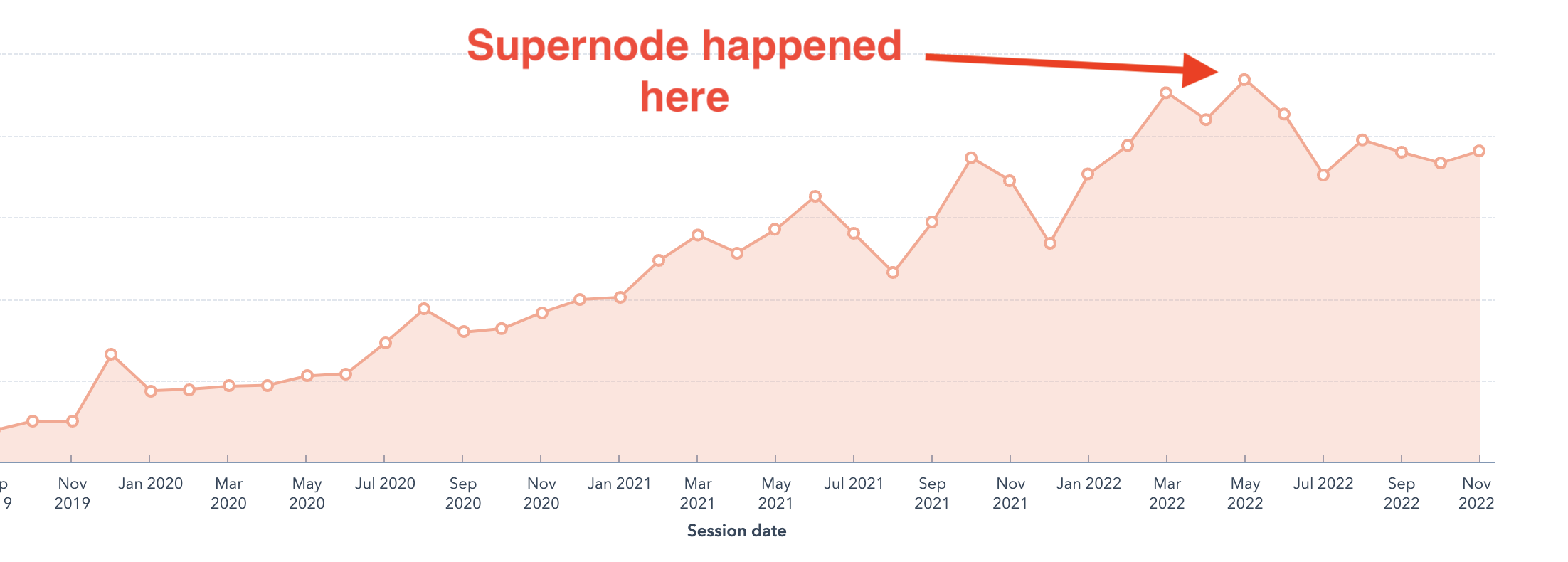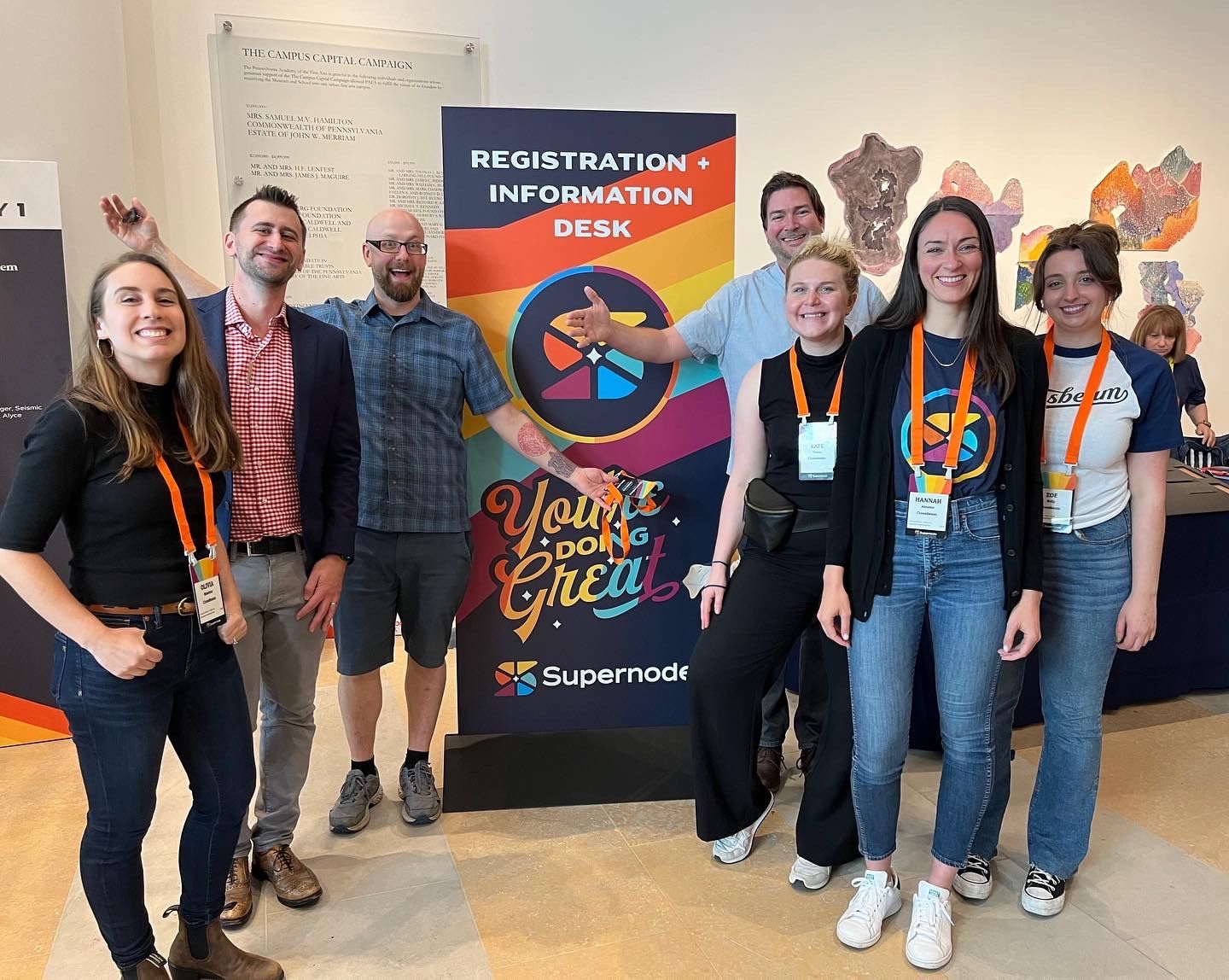6 Mindset Shifts For Scaling a Content Team
The messy transition from scrappy startup to grownup(ish) company.

The first phase of a startup’s journey often gets most of the attention. After all, it’s the one phase of building a company that everyone has to go through. Peter Thiel popularized this moment as the “Zero to One” phase.
Crossbeam, where I’ve served as the head of content since September 2019, is decidedly out of its first fragile moment and into the next. More than 12,000 companies now use the platform.

Various metrics that took us weeks to accomplish now take days.
That first phase of the company firmly ended in August 2021 when we raised $76 million from Andreessen Horowitz and others. And on the content side, so far, so good. Some highlights:
- In 2019 we had 22,000 people on our mailing list. Now it’s 50,000.
- Content is #2 source of new product signups (#1 is the product itself. PLG baby!)
- We hosted our first IRL conference (more on that later), and our first virtual event
- We’ve built out our YouTube channel, with 100K+ total views
- We’ve expanded to serve multiple personas (hello, sales professionals!)
- We’ve added additional talented team members, and now the content team is a mighty group of six people: Olivia Ramirez, Zoe Kelly, Kyle Ussery, Nick Beaulieu, Kate Young, and Jess Rowe

And most importantly, the audience we are serving continues to respond positively.




Suddenly, we are no longer wondering “will this thing be a business?” But “how successful of a business can this possibly be?” Will we end up as one of those cute, over-capitalized zombie startups? Or will we be able to continue to scale and serve even more markets and customers? And how can content help or, ugh, hurt that journey?
Operating as a “content leader” at this moment has been challenging for me. I’ve messed up a bunch of times and have had to change my approach.
After writing a post about starting your content career, and then starting a content department (see chart above for context), this is the next installment: The 6 things I had to shift my thinking on while navigating the transition from scrappy startup to grownup(ish) company.
I hope they help you on your own journey.
Mindset Shift #1: Scale on Your Own Terms
Coined by friend Christopher Wink, “Journalism Thinking” is the strategy of using journalism skills, workflows, and approaches to places you may not expect. It’s the way we run our content operation at Crossbeam.
Crossbeam content starts with speaking to a practitioner (not researching keyword) or some proprietary data/research . This effort is largely led by senior staff writer Olivia Ramirez and staff writer Zoe Kelly. They spend each day reaching out to and interviewing those that work in the partner ecosystem world and then distilling those insights into blog posts.
Some examples (all from Olivia and Zoe):
- Embedding with a sales professional to track partner-sourced vs cold lead workflows and success
- Taking a super obscure (but important!) part of the partnership workflow and doing several rounds of interviews with an expert to produce the only guide available
- Conducting ~10 interviews to assemble the ideal five co-selling “plays”
- Getting six actual org charts from real companies to help guide readers as they build out their own partnerships department
Those blog posts contain the raw material that shape everything else we do. It’s how we unearth possible conference speakers. It’s how we sniff out new trends, like “ecosystem-led growth”, quickly. Everything starts with assuming our audience knows more than we do, and speaking to them about it. They are labor intensive, and we publish once a week and rarely more.
In the early days, we did things this way because, candidly, we didn’t know a lot about the community we were covering + it’s my personal skillset. It's also a great way to build an audience, when you interview someone for a post, you are guaranteed at least one reader.
But I was convinced that when we grew I’d eventually have to dial this back and “make content” the way other companies do: optimizing for traffic, conversions, and other marketing-y metrics.
Then something funny happened: We gained new competitors. And most were running a "traditional" content playbook.
I had to shift my mindset and counterintuitively, more stubbornly insist on the “Journalism Thinking” approach. As you grow your content team, think about what you and your team are uniquely able to do. What is your “secret weapon” - the thing that endeared you to your readers in the first place?
Maybe you make videos your audience loves. Maybe it’s staying on the pulse of your business by publishing eight posts a day.
Whatever it is, triple down on it and codify it so you don’t lose it as you scale. If our team started to do things the way they are “supposed to” be done, we would be indistinguishable from any competitors.
As we scale, we continue to base each article on a conversation with the people with first-hand learnings. Sometimes these people do not want to talk to us. Sometimes they are purposefully below the radar. But that’s where the true insights are.
It’s hard work, and it’s our not-so-secret sauce.
Mindset Shift #2: Content Marketing is an Execution Game
At other companies, leaders would occasionally forward me some marketing post from some influencer about how they grew X by Y with this one weird trick. The email would sometimes have some message like “why aren’t we doing this?!?!”
As we scaled Crossbeam, I found myself looking for “easy” wins like this. I thought that if I just used a certain tool, or ran a specific campaign it would unlock all of this crazy growth. I was wrong.
Content marketing is a mature discipline and its tactics have been the same for nearly a decade. The platforms to drive audience have barely changed.
Chances are, you will not discover some hidden tactic or tool that will totally unlock the impact of your work beyond some small margin. No, my friend — at a certain point, you’ve written the blog posts, you’ve hosted the events, you’ve made the videos, you’ve recorded the podcasts and they just get thrown into the world wide web with everything else.
The difference maker and the only true “alpha” remaining in content marketing is creating things that people want. Write things people want to read. Host events people want to attend. It’s not by tricking some algorithm. It’s not piggybacking on some current event. The only thing you should care about is what your target audience thinks.
That’s it.
There is no shortcut. It’s just boring ol’ execution. There’s no marketing growth hack that will lead to sudden and long-lasting results here. After you make it out of survival mode you have to work on building franchises that are set up to be increasingly successful as time goes on.
It turns out the lesson that was re-learned in the last few years is that the biggest cheat code in startups is to find out there’s actually no cheat code. No shortcuts. Just build relentlessly and don’t get over your skis. That’s the lesson for 2023.
— Aaron Levie (@levie) December 28, 2022
Mindset Shift #3: Create Franchises, Not Campaigns
I used to think that we needed successful one-off campaigns. But as you scale, making new things from scratch every quarter can be a drag on growth.
The backbone of a growing content team is repeatable, anticipated marketing events. I’ll call these “franchises” — recurring moments that your audience looks forward to and derive a large amount of value from.

They also allow your team to get several chances to make better. This also allows new team members to team up with existing members to quickly get up to speed (important for scaling!).
At Crossbeam, the most successful content “franchise” we’ve managed to create in 2022 is our yearly in-person event, Supernode. We hosted the first Supernode in May 2022. When creating a new institution, it is important to be ambitious but not foolish. Unique but not confusing.

Every niche already has its long list of conferences it could attend, so we knew if we were going to enter the arena, we’d have to lock in on what made us different.
When we looked around the B2B partnerships space we saw lots of stilted events in large convention centers with panel after panel of sponsored speakers. Sure, the value of most conferences is in the hallways, but those building partner ecosystems, cannot do their job without a counterpart. That connection is more than just "nice for career development", it’s essential.



As a result, the first Supernode was less about the “content” and more about facilitating unique experiences that gave attendees a chance to meet one another. Some things we tried:
- Holding the event in an art museum/school rather than a conference center
- We randomly assigned attendees a spot at one of the tables at 15 restaurants picked by our Philly staff
- With one exception, had a single track of content so attendees had a shared experience
- We started late (10 a.m.) and allowed for 50-60 minute breaks between session to allow for maximum networking time
- We did not distribute the attendee list to any attendee or sponsor, there was no "official" way to set up meetings before you arrived, you had to be present and “find your people” at the event
Some of these worked better than others — for example, the single track resulted in some speakers being too junior or too advanced for attendees. However, we were proud of the result and are hosting our next Supernode in June 2023 in San Diego.

Mindset Shift #4: Your Job is to Safeguard Quality
When you’re in scrappy startup mode, your currency is market feedback. You need to release as much stuff as you can, see what the world thinks about it, and adjust quickly. From the previous post in this series:
You need to write stuff that appeals to the right person in the right way so they explore your product. You will get this wrong over and over again. Your only hope is to quickly adjust as you talk to your audience and publish new content.
But when you are trying to scale, you have a better idea of what works. You start repeating those “franchises” I mentioned above. People begin to have expectations for you and the brand that you help shepherd.
You can’t release poorly considered work into the market. You now have something to lose, something you can damage. And as the leader of your content team, any damage to the brand will make the entire company’s work more difficult.
You need to balance delegating the creation of publicly available materials like blog posts, social media, events, and branding to your very capable teams. But you also need to be there when it’s first conceived and again when it’s about to ship to safeguard the brand reputation you have worked for. Sometimes you have to kill stuff after people have worked very hard on it. Sometimes you have politely but meticulously explain why a certain request or idea would cause harm to your brand.
This means, when you get to a certain level, you need taste. Luckily this is not the Louvre, it’s B2B SaaS. Sometimes, the person with the best taste in the room is simply the person who is advocating for the customer/audience.
Everything you can think of being “ruined” by marketing and marketers is because that company stopped thinking of the people at the other end of the computer screen. You don’t produce content to track the pageviews or leads or insert-your-metric-here. You do it because actual human beings find a tiny bit of delight when they come across something your team does.
The members of a content team, and most marketing teams, are creatives at heart. They enjoy writing, designing, and producing things for people. As a leader it's your job to humanize your work, your team, and your audience.
You can never ever ever ever lose that. You can never ever ever get so “busy” or so jaded that you don’t have time to protect that. The moment your team feels like they are just shoveling content into yet another algorithm, they will disengage and everything becomes less fun.
The value of protecting the humanity of your work goes beyond your team, it affects the entire company. There’s a reason content leaders become brand leaders, the good ones spend time thinking equally about both.
As you scale, this is your primary role.
Mindset Shift #5: No Lone Wolves, Please
In late 2022, I asked our very talented People team to conduct a 360º review. They asked my managers, colleagues, and team members where I needed to improve. It was a necessary and humbling experience, and the feedback was loud and clear: I needed to communicate and delegate more.
As the proverb goes, if you want to go fast go by yourself. If you want to go far, go with others.
In a small startup, the more independent you are, the better. No one has time to formally train you, the best way to help the company and yourself is to move quickly and find product/market fit before the money runs out.
Start-up life = hard won insights. Here are my top 10 for this year.
— Julie Zhuo (@joulee) January 1, 2023
1. Doing well at a start-up is not simply about skill, it is about mentality.
A start-up mentality values action over correctness, results over process. It suits those that value autonomy over clarity.
On a content team, this usually means being a “team” of one. You think of the campaigns, you execute them, and you measure them.
As Crossbeam passed the 100-employee mark, we now have departments with more than one layer of management. There are people in our Slack that I no longer have a personal relationship with. This is normal and healthy for a growing company, but it changed the way I had to operate.
Now, we should plan months in advance. We should communicate to the entire company often what we are publishing and why. We should stay attuned to the product roadmap and do our best to align content with any themes. And as a leader, I should have tight feedback loops with my managerial counterparts to quickly disseminate learnings. This has been difficult for me, as I’d rather write stuff than host a Zoom call.
At a remote-first company like Crossbeam, it's possible that entire teams are working on things that you are not aware of. This means if you don’t work in public, you run the risk of doing something that undermines or counteracts another effort in the company.
If you ship the wrong thing quickly, you’re causing damage. As you scale, you need to balance speed with synchronization.
Mindset Shift #6: Work With People That Care
I used to think I only wanted to work with people who are good at their jobs. I wanted to kick ass and then go home. I still want that, but I find myself thinking of another layer as we grow: I want to work with people that fixate on the details and make sure the things we release into the world are thoughtful. Not necessarily “successful” or “impressive” (though that helps) — but thoughtful.
I am not an engineer. So who knows how many startups I’ll be able to watch grow from 14 to 100+ employees? From Series A to C (and perhaps beyond)? There are fewer positions in an early-stage company for liberal arts majors like me.
There’s a good chance I look back on today as one of the most fun and impactful stints in my career. And I want to make sure everyone I work with and everyone on my team feels the same way.

This is yet another area where I am in debt to the content team: Olivia Ramirez, Zoe Kelly, Kyle Ussery, Nick Beaulieu, Kate Young, and Jess Rowe. They’re all thoughtful, obsessed about the right things, and make Crossbeam a fun, creative place to be.
Yes, we all have to be good at our jobs. But it’s more important that we care and that we’re proud of our work. Once I made that mindset shift, I became more patient and a bit more focused on the long-term health of the company.
The thing I now spend the most time “creating” is an atmosphere for those around me to care and do good work.
What’s Next:
As I write this, markets are in disarray, venture capital funding has dried up, and tech layoffs are increasingly commonplace. At Crossbeam, we’re still full speed ahead. Some challenges and opportunities that the content team is focused on for 2023:
- Hosting a Supernode conference that is 3x bigger than the previous one, how can we increase the scope of Supernode without losing the communal feel?
- Our best customers use Crossbeam and “ecosystem-led growth” as a centerpiece of their GTM strategy. How can we “spread the gospel” to make it easier for others?
- What “franchises” should we stop doing? Which ones should we grow?
- And, most importantly, how can we do better work and still keep it fun?
2023 will look nothing like 2022 and will bring an entirely new set of challenges. Off we go.
(And if this is the kind of thing you love talking about or have questions about, please drop me a line at scblanda@gmail.com.)